1930s
1930s Fashion Trends
The 1930s was a time of transformation in fashion, blending functionality with style in ways that were both accessible and inspiring. From Hollywood’s glamour influence to technological advancements in textiles, this era offered a new perspective on how fashion could be both an art form and a reflection of societal changes.
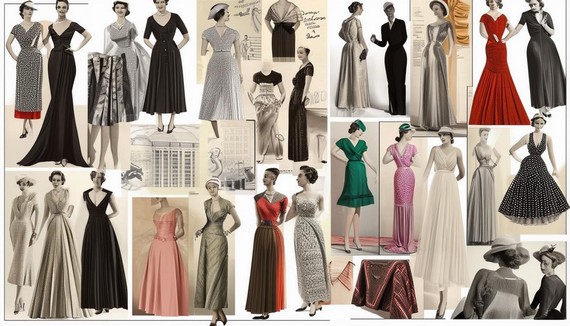
1930s fashion transformation
The Bias Cut Revolution
In the 1930s, the bias cut introduced a fresh sense of sensuality into fashion, transforming wardrobes across the globe. French designer Madeleine Vionnet pioneered this technique of cutting fabric at a 45-degree angle to the weave, creating garments that skimmed the body’s curves.
Evening gowns especially embraced this style, making formal events more glamorous than ever. Silks and satins seemed to flow with every movement, leaving a lasting impression. Women who wore these gowns appeared both effortless and elegant.
The bias cut wasn’t confined to evening wear. It influenced day-to-day fashion, giving even simple dresses a touch of flair. For working women, it meant clothes that offered comfort without sacrificing style. Office wear and casual day dresses were practical yet flattering.
This new approach also brought changes to necklines and backs. Evening wear featured low necklines, while day dresses often had backless designs. These styles required more supportive and flexible undergarments, which quickly evolved to meet the demand.
Fabrics like rayon, which had a silk-like sheen at a fraction of the cost, made these designs more accessible to a wider range of women. Wool crepes were popular for winter styles, ensuring the appeal of these sophisticated cuts year-round.
In an era of economic challenges, the bias cut defined an age of femininity and elegance. It offered women a chance to feel glamorous in their everyday lives, making Vionnet’s influence on fashion undeniable.
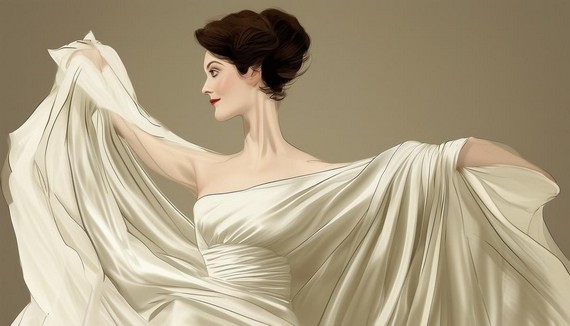
A white British woman wearing a flowing bias-cut evening gown in satin, showcasing the revolutionary design of Madeleine Vionnet
1930s Hollywood’s Influence on Fashion
Hollywood in the 1930s was a powerful cultural force that shaped fashion trends globally. Cinema stars like Greta Garbo and Joan Crawford became the ultimate fashion icons, their on-screen wardrobes serving as blueprints for women everywhere.
Joan Crawford’s dress in “Letty Lynton,” with its distinctive puffed sleeves, influenced formal wear for years. Copies of the dress were widely popular, demonstrating Hollywood’s ability to launch major fashion trends.
Greta Garbo, on the other hand, transformed simplicity into sophistication. Her understated elegance in films like “Mata Hari” inspired women to seek out long, sleek coats, wide-brimmed hats, and dresses with a touch of mystery.
The film industry’s influence extended beyond high-end fashion. As movie costumes were recreated for the mass market, it sparked a ready-to-wear movement. Women across different social classes could now emulate the refined styles they saw on screen, albeit at more affordable prices.
Hollywood didn’t just sell movies; it sold a lifestyle. During a time of economic hardship, these glamorous images offered an escape and inspired women to bring a touch of that silver screen magic into their own lives through fashion.
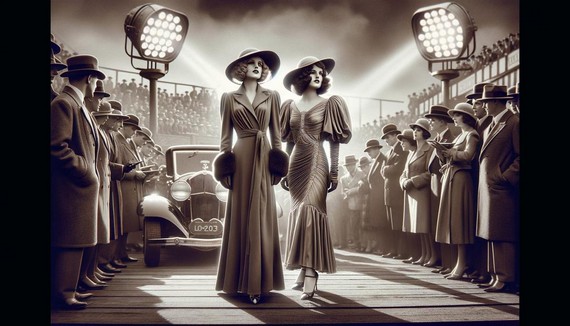
A glamorous scene featuring Greta Garbo and Joan Crawford in iconic 30s Hollywood fashion, influencing global style trends
1930s Daywear Versus Evening Glamour
In 1930s fashion, there was a clear distinction between practical daywear and glamorous evening attire. Daywear focused on practicality and elegance, reflecting the era’s need for functionality in an increasingly busy world.
- Daywear fabrics: Cotton and rayon
- Popular prints: Floral and abstract
- Key features: Defined waist, elaborate sleeves
Evening wear, in contrast, was all about opulence. Luxurious materials like silk and satin dominated, with gowns designed to catch the light and create a dramatic effect. The bias cut was particularly popular for evening gowns, creating flowing silhouettes that skimmed the body’s curves. Plunging backs and enticing necklines added to the allure of these designs.
This contrast in styles reflected the era’s social and economic dynamics. Daywear mirrored the need for practicality during challenging times, while evening wear offered a temporary escape into glamour and fantasy. Together, these styles showcased fashion’s ability to both meet everyday needs and provide moments of luxury and aspiration.
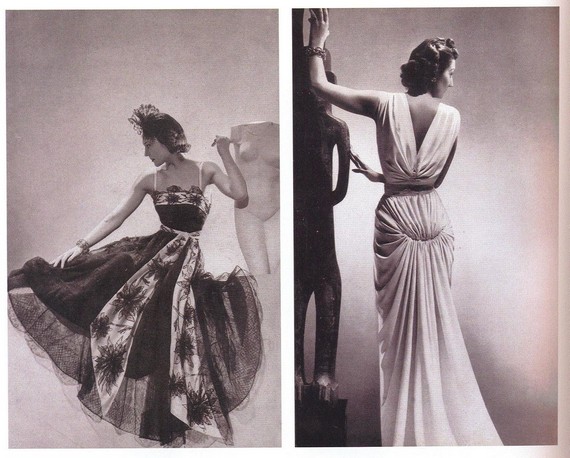
A split image contrasting 1930s daywear and evening wear, showcasing the stark difference in styles and materials
1930s Technological Advances in Fashion
The 1930s saw significant technological advancements in fashion, particularly in textile production. These innovations changed how clothes were made and worn, making style more accessible to a broader audience.
Rayon, known as ‘artificial silk,’ became a popular fabric in the early 1930s. It offered the luxurious look of silk at a more affordable price, making it ideal for both day and evening wear. Its versatility allowed it to be used in everything from lingerie to dresses, democratizing fashion.
Nylon, developed by Du Pont, was another breakthrough. Known for its strength and elasticity, it revolutionized hosiery when introduced in 1939. Nylon stockings offered a glamorous finish that could withstand daily wear, combining functionality with allure.
Zippers also gained popularity during this decade. Initially met with resistance, they soon became a design feature in their own right. Designers like Elsa Schiaparelli incorporated zippers into their creations, adding both convenience and style to garments.
These technological advances contributed to the growth of the ready-to-wear industry. They made fashionable clothing more accessible and varied, allowing women to expand their wardrobes without excessive cost. The 1930s proved that innovation could serve both practical needs and style preferences, making fashion a more inclusive and dynamic field.
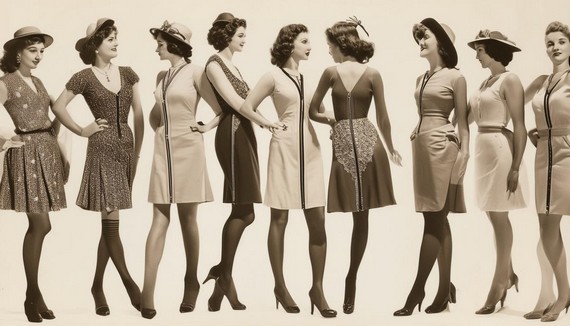
A montage of 1930s fashion technology innovations, featuring rayon fabric, nylon stockings, and stylish zippers
The 1930s demonstrated that fashion could blend elegance and practicality in a way that resonated with the spirit of the times. It was an era where clothing became a means of personal expression and aspiration, leaving a lasting impact on style history.
References:
- Blackman C. 100 Years of Fashion. Laurence King Publishing; 2012.
- V&A Museum. Fashion in the 1930s. Victoria and Albert Museum; 2021.
- Vogue. The Figure Then the Frock. Vogue; 1931.
Related posts:


